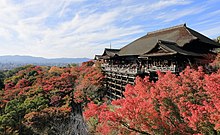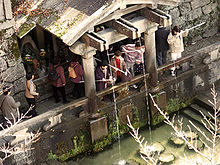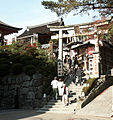Kiyomizu-dera

Kiyomizu-dera ( Japanese 清水寺 ) denotes several Buddhist temples , but mostly it refers to the Otowasan Kiyomizudera ( 音 羽山 清水寺 ) in eastern Kyoto ( Higashiyama district ), one of the most famous sights of the city. The temple was along with other sites for 1994 UNESCO - World Heritage Historic Kyoto (Kyoto, Uji and Otsu Cities) appointed. The Kiyomizu-dera is the sixteenth temple of the Saigoku pilgrimage route ( 西 国 三十 三 箇 所 , Saigoku sanjūsankasho ).
The history of the temple goes back to the year 798, however the current buildings were erected in 1633. The temple got its name from the waterfall within the temple complex that comes down from the nearby hills - kiyoi mizu ( 清 い 水 ) literally means pure water .
The main hall of Kiyomizu-dera is known for its wide terrace , which was built together with the main hall on a wooden beam construction on a steep mountain slope. The terrace offers an impressive view of the city. The temple bought the surrounding land to prevent high-rise buildings from being built.
The Japanese phrase "to jump down the terrace of the Kiyomizu" ( 清水 の 舞台 か ら 飛 び 降 り る kiyomizu no butai kara tobioriru ) means “to make a decision”. This is reminiscent of a tradition from the Edo period , according to which a person who dared to jump off the terrace, all wishes were granted. This seems believable as the lush vegetation under the terrace dampens the impact. 234 jumps were documented in the Edo period, of which 85.4% of jumpers survived the jump (nowadays it is forbidden to jump from the terrace). The distance from the terrace to the bottom is only 13 m, but this is an impressive height for such a wooden structure.
A wide staircase leads to the foot of the slope next to the main hall. Here is the waterfall of Otowa-no-taki , where three individual water channels plunge into a basin. Temple goers catch the water in metal bowls and drink it, as it is said to have healing powers and bring health, longevity and success.
The temple complex is also home to several Shinto shrines , notably Jishu-jinja , which is dedicated to Ōkuninushi -no-mikoto, a god of love. There is a pair of “love stones” on the grounds that are 10 m apart. It is said that people who find their way from one stone to another with their eyes closed will soon fall in love. This is particularly popular with Japanese schoolgirls. When the person walking is helped, it means that a facilitator brings the lovers together.
On the main access road to the temple, which is one of the most visited sights in the city, souvenir shops are lined up: traders offer various talismans for sale, incense and o-mikuji (forward-looking lots with labels ranging from “great luck” to “great misfortune”) ) are in abundance.
photos
Web links
- Official website of the Kiyomizu-dera
- Official website of the Jishu-jinja
- Kiyomizu-dera - Good website with a map of the temple and pictures of most of the buildings
Individual evidence
Coordinates: 34 ° 59 ′ 41.61 ″ N , 135 ° 47 ′ 5.91 ″ E










